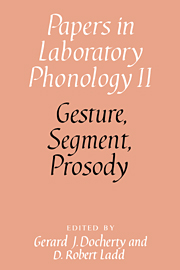Book contents
- Frontmatter
- Contents
- List of contributors
- Acknowledgments
- Introduction
- Section A Gesture
- Section B Segment
- 6 An introduction to feature geometry
- 7 The segment: primitive or derived?
- 8 Modeling assimilation in nonsegmental, rule-free synthesis
- 9 Lexical processing and phonological representation
- 10 The descriptive role of segments: evidence from assimilation
- 11 Psychology and the segment
- 12 Trading relations in the perception of stops and their implications for a phonological theory
- Section C Prosody
- Appendix 1 The test phrases (bold type) of experiment 1 in the context in which they were read
- Appendix 2 The distractors (bold type) of experiment 1 in the context in which they were read
- Appendix 3 The test sentences of experiment 2. The test words are in bold type
- Appendix 4 The distractor sentences of experiment 2. The distractors are in bold type
- References
- Name index
- Subject index
7 - The segment: primitive or derived?
from Section B - Segment
Published online by Cambridge University Press: 18 December 2009
- Frontmatter
- Contents
- List of contributors
- Acknowledgments
- Introduction
- Section A Gesture
- Section B Segment
- 6 An introduction to feature geometry
- 7 The segment: primitive or derived?
- 8 Modeling assimilation in nonsegmental, rule-free synthesis
- 9 Lexical processing and phonological representation
- 10 The descriptive role of segments: evidence from assimilation
- 11 Psychology and the segment
- 12 Trading relations in the perception of stops and their implications for a phonological theory
- Section C Prosody
- Appendix 1 The test phrases (bold type) of experiment 1 in the context in which they were read
- Appendix 2 The distractors (bold type) of experiment 1 in the context in which they were read
- Appendix 3 The test sentences of experiment 2. The test words are in bold type
- Appendix 4 The distractor sentences of experiment 2. The distractors are in bold type
- References
- Name index
- Subject index
Summary
Introduction
The segmental or articulated character of speech has been one of the cornerstones of phonology since its beginnings some two-and-a-half millennia ago. Even though segments were broken down into component features, the temporal coordination of these features was still regarded as a given. Other common characteristics of the segment, not always made explicit, are that they have a roughly steady-state character (or that most of them do), and that they are created out of the same relatively small set of features used in various combinations.
Autosegmental phonology deviates somewhat from this by positing an underlying representation of speech which includes autonomous features (autosegments) uncoordinated with respect to each other or to a CV core or “skeleton” which is characterized as “timing units.” These autonomous features can undergo a variety of phonological processes on their own. Ultimately, of course, the various features become associated with given Cs or Vs in the CV skeleton. These associations or linkages are supposed to be governed by general principles, e.g. left-to-right mapping (Goldsmith 1976), the obligatory contour principle (Leben 1978), the shared feature convention (Steriade 1982). These principles of association are “general” in the sense that they do not take into account the “intrinsic content” of the features (Chomsky and Halle 1968: 400ff.); the linkage would be the same whether the autosegments were [± nasal] or [± strident].
- Type
- Chapter
- Information
- Gesture, Segment, Prosody , pp. 166 - 189Publisher: Cambridge University PressPrint publication year: 1992
- 21
- Cited by

